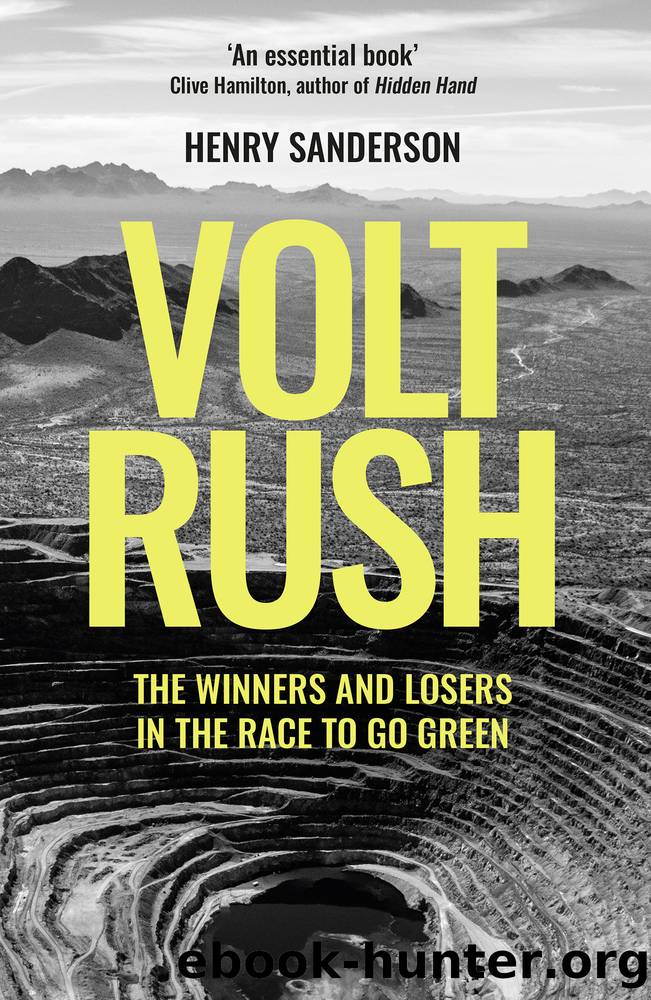Volt Rush by Henry Sanderson

Author:Henry Sanderson
Language: eng
Format: epub
ISBN: 9780861543755
Publisher: Oneworld Publications
__________
* Chinaâs reliance on imported cobalt from the Congo is its greatest reliance on one country for any commodity, more than iron ore, which is mostly mined in Australia and Brazil.
10
Dirty Nickel
âPlease mine more nickel ⦠Tesla will give you a giant contract for a long period of time if you mine nickel efficiently and in an environmentally sensitive way ⦠Hopefully this message goes out to all mining companies. Please get nickel!â
Elon Musk, Tesla CEO1
In the summer of 2019, Swiss mining consultant Alex Mojon was invited to the island of Papua New Guinea (PNG) in the South Pacific to carry out an environmental assessment of a Chinese-run nickel and cobalt mining project that had been disposing of waste into a local bay. The mineâs processing plant, an area of circular tanks and smoke-emitting chimneys, had been carved out of the forest, right next to the water on PNGâs north coast. The nickel was mined further inland in the Kurukumbari mountains, and then sent through a 134-kilometre pipeline to the refinery. The rock dug up inland contained less than one percent nickel, meaning there was a huge amount of waste to be disposed of and forests had to be cleared to mine enough of it. Normally mining companies built large dams on land to store mining waste, but the Ramu mine disposed of its waste directly into the sea, at a depth of 150 metres â a method known as deep sea tailings displacement. The theory was that the waste, being heavier, would slip down to the ocean floor at around 1,500 metres where it would rest undisturbed.
A few months after his first visit a series of pipeline leaks at the refinery turned the local sea red. There were reports of dead fish and âpeople developing complications after allegedly eating contaminated fish and swimming in the seaâ.2 The local Madang provincial government called it the worst disaster in Papua New Guineaâs history and put in place a fishing ban, cutting off one of the main sources of livelihood for locals.
Mojon returned to PNG in September for a second visit. Accompanied by soldiers Mojon, a short and stocky man in a khaki waistcoat, took food and water samples from local villages to take back to a laboratory in Munich for testing. One woman brought out her child who she said she believed may have been deformed by the activities of the Ramu mine. In one district he saw a dead dolphin that had been washed up onto the beach, and took a sample from it. On a third trip in October Mojon discovered algae-like brown-red filaments floating around three kilometres out to sea and ten kilometres north-west of the plant. Local fishermen told him they had never seen such vegetation before.
Mojon, who had a long career as a mining and petroleum geologist, was shocked by the amount of waste the Ramu mine was routinely dumping into the ocean. While the waste itself was not that dangerous, its sheer volume could smother the seabed or marine ecosystems if it resurfaced.
Download
This site does not store any files on its server. We only index and link to content provided by other sites. Please contact the content providers to delete copyright contents if any and email us, we'll remove relevant links or contents immediately.
| Alternative & Renewable | Drilling Procedures |
| Electric | Fossil Fuels |
| Mining | Nuclear |
| Power Systems |
Whiskies Galore by Ian Buxton(41875)
Introduction to Aircraft Design (Cambridge Aerospace Series) by John P. Fielding(33064)
Small Unmanned Fixed-wing Aircraft Design by Andrew J. Keane Andras Sobester James P. Scanlan & András Sóbester & James P. Scanlan(32743)
Craft Beer for the Homebrewer by Michael Agnew(18140)
Turbulence by E. J. Noyes(7935)
The Complete Stick Figure Physics Tutorials by Allen Sarah(7307)
Kaplan MCAT General Chemistry Review by Kaplan(6866)
The Thirst by Nesbo Jo(6826)
Bad Blood by John Carreyrou(6546)
Modelling of Convective Heat and Mass Transfer in Rotating Flows by Igor V. Shevchuk(6391)
Learning SQL by Alan Beaulieu(6209)
Weapons of Math Destruction by Cathy O'Neil(6142)
Man-made Catastrophes and Risk Information Concealment by Dmitry Chernov & Didier Sornette(5921)
Digital Minimalism by Cal Newport;(5662)
Life 3.0: Being Human in the Age of Artificial Intelligence by Tegmark Max(5474)
iGen by Jean M. Twenge(5366)
Secrets of Antigravity Propulsion: Tesla, UFOs, and Classified Aerospace Technology by Ph.D. Paul A. Laviolette(5309)
Design of Trajectory Optimization Approach for Space Maneuver Vehicle Skip Entry Problems by Runqi Chai & Al Savvaris & Antonios Tsourdos & Senchun Chai(5011)
Pale Blue Dot by Carl Sagan(4909)
